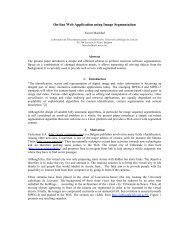motion estimation and compensation for very low bitrate video coding
motion estimation and compensation for very low bitrate video coding
motion estimation and compensation for very low bitrate video coding
You also want an ePaper? Increase the reach of your titles
YUMPU automatically turns print PDFs into web optimized ePapers that Google loves.
1.2 Video Coding 19<br />
exhaustive use of the two fol<strong>low</strong>ing types of pictures:<br />
Intra-images: When <strong>coding</strong> an image in intra mode, only the<br />
spatial correlation inherent to the picture itself is exploited. In<br />
fact, an intra-image is an isolated picture <strong>and</strong> is compressed as<br />
such (cf. the JPEG [135] algorithm <strong>for</strong> still pictures compression).<br />
Inter-images: These images are speci c to <strong>video</strong> sequences in<br />
comparison with still pictures. They al<strong>low</strong> the coder to exploit<br />
the spatio-temporal correlation between the present image <strong>and</strong><br />
the previous one(s) within a sequence. The classical tool used to<br />
achieve compression on such images is <strong>motion</strong> <strong>estimation</strong> & <strong>compensation</strong><br />
which al<strong>low</strong>s one to obtain a prediction of the present<br />
image from the previous one(s).<br />
{ Residues: As the <strong>estimation</strong> & <strong>compensation</strong> of an interimage<br />
is not perfect, the di erence between the estimate <strong>and</strong><br />
the original image is computed: the so-called Displaced Frame<br />
Di erence (DFD) has to be sent if it is relevant enough. It can<br />
only be transmitted on its own basis, i.e. as an intra-image.<br />
The rst image of a sequence must of course be encoded as an intraimage.<br />
For the subsequent images, a scene-cut detector compares the<br />
new image with the previous one(s) to check if some temporal correlation<br />
still exists. In the a rmative, the new image will be inter-coded.<br />
Otherwise, the coder considers that a scene-cut has occurred: the new<br />
image di ers so much from the previous one(s) that it is better to encode<br />
it as an intra-image. The user may also en<strong>for</strong>ce intra-image <strong>coding</strong> to<br />
take place e<strong>very</strong> x seconds to o er speci c functions like fast retrieval,<br />
temporal scalability or resynchronization in case of noisy channel.<br />
According to these considerations, one can a rm that the scheme presented<br />
on gure 1.2 (from [13]) is typical of most (VLBR) <strong>video</strong> coders.<br />
The rst image is intra-coded. Then the second image is <strong>motion</strong> estimated<br />
on the basis of the rst one (original or reconstructed). The<br />
<strong>motion</strong> vectors of course need to be sent to the decoder in order to al<strong>low</strong><br />
it to behave the same way. The <strong>motion</strong> vector eld is applied to the<br />
rst image thereby obtaining a prediction of image two, which is used<br />
<strong>for</strong> the DFD computation. This DFD is the residual image that also<br />
needs to be coded. The process goes on until some scene cut arises or<br />
until a de ned threshold en<strong>for</strong>ces to start again with an intra-image.





